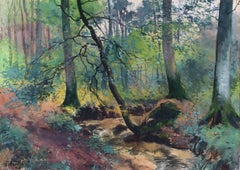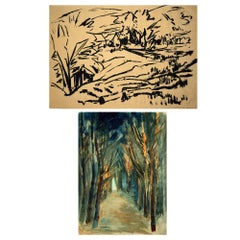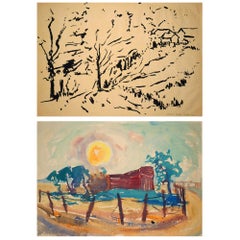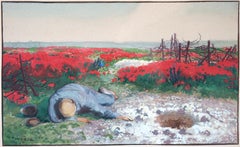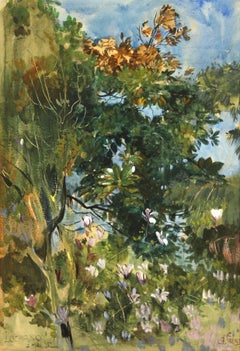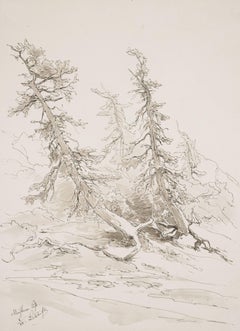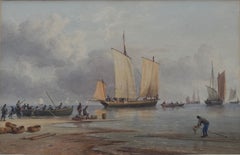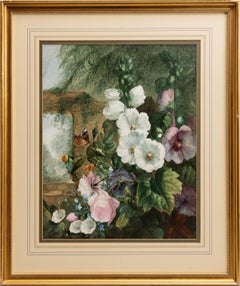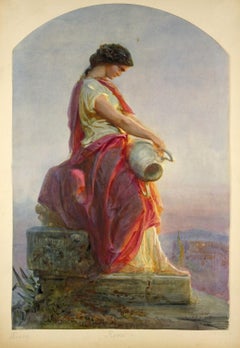Berlin - Landscape Drawings and Watercolors
to
13
10
4
3
Overall Width
to
Overall Height
to
5
12
1
2
1
3
1
2
1
11
6
5
5
4
4
3
2
2
2
2
2
2
2
1
1
1
1
1
1
1
1
9
9
8
2
1
2
1
1
8
4,706
3,349
Item Ships From: Berlin
Summer Forest Landscape, 1915 / - The Forest Walk -
Located in Berlin, DE
Stanislas Warnie (1879-1958), Summer Forest Landscape, 1915. Watercolor, 31.5 cm x 45 cm (passepartout), 50.5 cm x 63.5 cm (frame), signed "S. Warnie" at lower left and dated "1915"....
Category
1910s Art Nouveau Berlin - Landscape Drawings and Watercolors
Materials
Watercolor
$612 Sale Price
20% Off
Landscape verso Forest interior / - Landscape as a space of imagination -
Located in Berlin, DE
Herbert Seidel (1906 Berlin - 1974 Rüdersdorf), Landscape verso Forest interior, around 1950. India ink on grained, bleached paper, 40.5 x 58 cm, signed “Herbert Seidel” in pencil on...
Category
1950s Abstract Berlin - Landscape Drawings and Watercolors
Materials
Paper
Autumn verso Summer Landscape / - Imagined Landscape -
Located in Berlin, DE
Seidel, Herbert (1906-1974), Autumn verso Summer Landscape, 1953
Herbert Seidel (1906 Berlin - 1974 Rüdersdorf), Autumn verso Summer Landscape, 1953. India ink on grained, bleached p...
Category
1950s Abstract Berlin - Landscape Drawings and Watercolors
Materials
Paper
Red blooming war landscape with dead soldier - Bleeding flowers -
Located in Berlin, DE
Johannes Friedrich Heinrich Hänsch (1875-1945), Red blooming war landscape with dead soldier, 1918. Watercolor and gouache on paper, 15 x 24.5 cm (image), 27 x 37 cm (sheet size / frame), monogrammed and dated "19JH18" at lower left.
- Paper slightly darkened
About the artwork
Despite the relatively small format, the watercolor with an internal frame depicts a panoramic view of a flat landscape stretching to the horizon. As far as the eye can see, the poppies bloom in flaming red. The flowers are not rendered individually, however, creating an almost cohesive red surface. The bright red is interspersed with vegetal green. A complementary contrast that creates an intense color effect. In this color contrast, a white area breaks through from the middle ground, widening towards the foreground and surrounding a brown hole. Next to it, in blue, is the actual protagonist of the painting, the first thing that catches the eye: a dead soldier. Next to him is his helmet, revealing the empty interior. The brown, hollow shape corresponds to the hole in the ground. A shell funnel is surrounded by bright ash, which, like the inverted helmet, becomes a sign of death. The soldier's arms point to the funnel, while the empty helmet paraphrases the calotte of the skull and, like the funnel, thematizes the empty darkness of death.
The soldier's body, however, is intact and not - as in Otto Dix's triptych "The War" - a dismembered corpse. Instead, Johannes Hänsch activates the landscape, especially the color, to illustrate a blooming landscape of death that extends from the shell funnel in the foreground to the rising column of smoke on the horizon. If the soldier's body is intact, the tangle of barbed wire emblematically placed over the empty helmet also appears tattered. On the right side of the picture, the barbed wire even seems to stretch its arms to the sky in horror. Against the background of this allegory, the content of the bright red also becomes clear: the landscape is drenched in blood, literally a sea of blood, and the single unknown soldier stands pars pro toto for all those who died on the battlefield. Dying in war is not dying in community, but in solitude. In order to emphasize the isolation in death, Johannes Hänsch has set the blue of the soldier in the axis given by his body in the middle ground of the picture into the red sea.
A master of landscape painting, Hänsch succeeds in creating a natural-looking landscape allegory that illustrates the horror and death of war, without depicting the brutality of war itself. This singular 'war memorial' of the unknown soldier is the opposite of heroization and yet the dignity of the deceased soldier is preserved through the integrity of his body.
About the artist
As the son of the sculptor Adolf Haensch, the young Johannes received his first artistic training in his father's Berlin studio. However, he eventually decided to become a painter, and in 1897 he entered the Berlin Academy of Arts. He initially studied under Paul Vorgang and Eugen Bracht, and was particularly influenced by Bracht's increasingly colourful landscape painting. In 1901 he moved to the class of Friedrich Kallmorgen, with whom he spent several weeks on excursions into nature. In 1905 he became a master pupil of Albert Hertel, who taught him watercolour painting.
From 1903 to 1933 he exhibited annually at the Great Berlin Art Exhibition, the exhibitions of the Berlin Artists' Association and the Munich Glaspalast. In 1905 he was awarded the Carl Blechen...
Category
1910s Realist Berlin - Landscape Drawings and Watercolors
Materials
Watercolor
$1,322 Sale Price
20% Off
Plant Impression in Locarno - Floral Crescendo -
Located in Berlin, DE
Alexander Frenz (1861 Rheydt - 1941 Düsseldorf). Plant impression in Locarno. Gouache and watercolour. 35 x 23,5 cm (visible size), 49,5 x 38,5 cm (fra...
Category
1890s Impressionist Berlin - Landscape Drawings and Watercolors
Materials
Watercolor
$867 Sale Price
20% Off
Woodland / - The Inner Drama of the Landscape -
Located in Berlin, DE
Eduard Peithner von Lichtenfels (1833 Vienna - 1913 Berlin), Woodland, 1884. Watercolor and pen and ink on drawing paper, 30.4 cm x 22.5 cm, signed, dated and inscribed by the artist...
Category
1880s Berlin - Landscape Drawings and Watercolors
Materials
Paper
Lonely and lively lake / - Calm and Movement -
Located in Berlin, DE
Reinhard Stangl (*1959 Leipzig), Lonely and lively lake, 1985. White heightened blue colored pencil drawings on brown paper, each 21 cm x 29 cm, signed lower right and once dated 198...
Category
1980s Realist Berlin - Landscape Drawings and Watercolors
Materials
Paper
The Ruins of St. Clement's Church in Visby, Sweden / - Real romanticism -
Located in Berlin, DE
Otto Günther-Naumburg (1856-1941), The Ruins of St. Clement's Church in Visby, Sweden. Watercolor and ink, heightened with white, on sand-colored paper, mounted on cardboard, 33 x 24...
Category
Early 20th Century Realist Berlin - Landscape Drawings and Watercolors
Materials
Paper
Wettersteinkamm - The blue of the mountains -
Located in Berlin, DE
Adalbert Holzer (1881 Munich - 1966 Munich). Wettersteinkamm. Watercolour, 29 x 34.5 cm (visible size), 37.5 x 43 cm (frame), signed and dated at lower right 'ADALBERT HOLZER [19]23'.
Framed behind glass. Frame shows signs of wear.
- The blue of the mountains -
About the artwork
The Wetterstein ridge is revealed to the viewer from a gentle, snow-covered hill. In contrast to conventional depictions of mountains, the painting is composed entirely of shades of blue, which condense into the blue-grey of the rock or fade into the white of the snow. As a complementary colour to the blue, Holzer virtuously activates the ochre ground. The uniform yet exciting polarity of the colours emphasises the massive majesty of the mountains and at the same time underlines the special character of the Wetterstein ridge. Holzer transferred the translucency of glass painting, in which he was originally trained, to watercolour and developed a pictorial language related to the art of Ferdinand Hodler, which earned him the nickname 'Master of Blue' and led to the appreciation of his watercolours in particular.
About the artist
After an apprenticeship as a stained glass painter at the Kunstgewerbeschule, Adalbert Holzer studied at the Munich Art Academy under Carl von Marr...
Category
1920s Realist Berlin - Landscape Drawings and Watercolors
Materials
Watercolor
$895 Sale Price
20% Off
Norwegian Pine Grove - The inner glow of the trees -
Located in Berlin, DE
Themistokles von Eckenbrecher (1842 Athens - 1921 Goslar), Norwegian pine grove, 1901. Watercolor on blue-green paper, 30 x 22 cm. Signed, dated and inscribed in his own hand "TvE. Fagermes [i.e. Fagermes]. 26.6.[19]01."
- Slight crease throughout at left margin, otherwise in good condition.
About the artwork
Themistokles von Eckenbrecher often traveled to Norway to study the nature that fascinated him there. On June 26, 1901, near the southern Norwegian town of Fagernes, in the summer evening sun, he saw a small pine grove, which he immediately captured in a watercolor. He exposed the trees growing on a small hill in front of the background, so that the pines completely define the picture and combine to form a tense motif. The tension comes from the contrast of form and color. The trunks, growing upward, form a vertical structure that is horizontally penetrated by the spreading branches and the pine needles, which are rendered as a plane. This structural tension is further intensified by the color contrast between the brown-reddish iridescent trunks and branches and the green-toned needlework.
Themistokles von Eckenbrecher, however, does not use the observed natural scene as an inspiring model for a dance of color and form that detaches itself from the motif and thus treads the path of abstracting modernism. Its inner vitality is to be brought to light and made aesthetically accessible through the work of art.
It is precisely in order to depict the inner vitality of nature that von Eckenbrecher chooses the technique of watercolor, in which the individual details, such as the needles, are not meticulously worked out, but rather a flowing movement is created that unites the contrasts. The trees seem to have formed the twisted trunks out of their own inner strength as they grew, creatingthose tense lineations that the artist has put into the picture. The inner strength continues in the branches and twigs, culminating in the upward growth of the needles. At the same time, the trunks, illuminated by the setting sun, seem to glow from within, adding an almost dramatic dimension to the growing movement.
Through the artwork, nature itself is revealed as art. In order to make nature visible as art in the work, von Eckenbrecher exposes the group of trees so that they are bounded from the outside by an all-encompassing contour line and merge into an areal unity that enters into a figure-ground relationship with the blue-greenish watercolor paper. The figure-ground relationship emphasizes the ornamental quality of the natural work of art, which further enforces the artwork character of the group of trees.
With the presentation of Themistokles von Eckenbrecher's artistic idea and its realization, it has become clear that the present watercolor is not a study of nature in the sense of a visual note by the artist, which might then be integrated into a larger work context, but a completely independent work of art. This is why von Eckenbrecher signed the watercolor. In addition, it is marked with a place and a date, which confirms that this work of nature presented itself to him in exactly this way at this place at this time. At the same time, the date and place make it clear that the natural work of art has been transferred into the sphere of art and thus removed from the time of the place of nature.
About the artist
Themistocles' parents instilled a life of travel in their son, who is said to have spoken eleven languages. His father, who was interested in ancient and oriental culture, was a doctor and had married Francesca Magdalena Danelon, an Italian, daughter of the British consul in Trieste. During a stay in Athens - Gustav von Eckenbrecher was a friend of Heinrich von Schliemann and is said to have given him crucial clues as to the location of Troy - Themistokles saw the light of day in 1842.
After an interlude in Berlin, where Themistokles was educated at the English-American School, the journey began again. From 1850 to 1857 the family lived in Constantinople, after which the father opened a practice in Potsdam, where Themistokles, who wanted to become a painter, was taught by the court painter Carl Gustav Wegener.
In 1861 the von Eckenbrechers left Potsdam and settled in Düsseldorf. There Themistokles received two years of private tuition from Oswald Aschenbach, who greatly admired the talented young artist. After his artistic training, he undertook extensive travels, often accompanied by Prince Peter zu Sayn-Wittgenstein, which took him to northern and eastern Europe, but above all to the Middle East and even to South America. The paintings that resulted from these journeys established his artistic reputation and led to his participation in large panoramas such as the 118 x 15 metre Entry of the Mecca Caravan into Cairo, painted for the City of Hamburg in 1882.
1882 was also the start of a total of 21 study trips to Scandinavia, most of them to Norway, and the unique Norwegian landscape with its rugged fjords became a central motif in his work. Along with Anders Askevold and Adelsteen Normann...
Category
Early 1900s Naturalistic Berlin - Landscape Drawings and Watercolors
Materials
Watercolor
$1,133 Sale Price
20% Off
Clay jug on a bench - The essence of the clay jar revealed by the sunlight -
By Hans Richard von Volkmann
Located in Berlin, DE
Hans Richard von Volkmann (1860 Halle (Saale) - 1927 ibid.), Clay jug on a bench. Pencil and Watercolour on paper. 20 x 26,7 cm (visible size), 37 x 45 cm (frame), dated and monogrammed lower left "Februar 1890 - HR. V. V."
- Minimally tanned. Framed behind glass in a passepartout.
About the artwork
Using the technique of his early youth - pencil and watercolour - Hans Richard von Volkmann depicts a still life. However, this is not a conventional indoor still life, but an open-air depiction, painted outdoors and not in the studio. It is therefore an open-air painting, characteristic of von Volkmann's oeuvre, which could have been painted in the Willingshausen colony of painters, where open-air painting was programmatically practised there and the artist stayed there that year.
And indeed, this painting is a manifesto of open-air painting. Von Volkmann demonstrates that leaving the studio for the light of nature leads to an entirely new quality of art. To prove this, he uses the genre of still life, which can be described as the studio subject par excellence. Moreover, light plays an essential role in the classical still life. It is the real protagonist of the still life. And it is precisely this moment, essential to the still life, that von Volkmann exploits to demonstrate the potential of plein-air painting: He presents the objects as they appear in the sunlight. The date of February and the bare branches in the foreground make it clear that this is a clear winter day in bright sunlight. The delicate plant in the foreground casts a clearly defined shadow, as does the jug. However, the shadow is most pronounced on the jug itself: The underside of the handle appears almost black, making the top, and therefore the jug itself, shine all the more brightly. The shining of the objects in the sunlight is also visible on the bench. As complementary phenomena to the shadow zones, light edges can be seen on the boards of the seats and the upper foot of the bench shines entirely in the light. To achieve this intensity of light, von Volkmann activated the bright white of the painting ground.
By depicting the objects in glistening sunlight, von Volkmann demonstrates that this quality of light is only to be found outdoors. And this light leads to a new way of looking at the objects themselves. The jug on the bench seems like an accidental arrangement, as if the artist had stumbled upon this unintentional still life and captured it with fascination. And in this fascination there is a moment of realisation that refers to the objects themselves. It is only when they shine brightly in the sunlight that their true nature is revealed. In this way, sunlight allows the objects to come into their own, so to speak. Sunlight, which is not present in the studio, gives the still life an entirely new dimension of reality, which is also reflected in the colours interwoven by the sunlight: The bench and the jug stand in a harmonious grey-pink contrast to the green of the implied meadow.
The emphasis on the jug as the central subject of the picture also implies that the watercolour has not been completed. This non finito inscribes a processuality into the picture, making it clear that something processual has been depicted, the temporality of which has been made artistically permanent. This is why von Volkmann signed the painting and dated it to the month.
About the Artist
Von Volkmann made his first artistic attempts at the age of 14. He painted many watercolours of his home town of Halle. This laid the foundation for his later outdoor painting.
In 1880 his autodidactic beginnings were professionalised with his admission to the Düsseldorf Art Academy. There he studied under Hugo Crola, Heinrich Lauenstein, Johann Peter Theodor Janssen and Eduard von Gebhardt until 1888. Von Volkmann then moved to the Karlsruhe Academy, where he was Gustav Schönleber's master pupil until 1892.
In 1883 he came for the first time to Willingshausen, Germany's oldest painters' colony, at the suggestion of his student friend Adolf Lins...
Category
1890s Naturalistic Berlin - Landscape Drawings and Watercolors
Materials
Watercolor
High Moorland Landscape in the fog - The world as a transcendent phenomenon -
Located in Berlin, DE
Charles Edward Brittan Jr (1870 Plymouth - 1949). High moor landscape in the fog. Gouache, signed at lower left "Charles E. Brittan", 18 x 34.5 cm (passepartout), 45 x 62 cm (frame)....
Category
Early 20th Century Realist Berlin - Landscape Drawings and Watercolors
Materials
Watercolor
$1,700 Sale Price
20% Off
Wind Dodgers at the Baltic Sea / - The Sensuousness of the Baltic Sea -
Located in Berlin, DE
Theodor Scheerbaum (1897 Reichenbach im Vogtland), Wind Dodgers at the Baltic Sea. Watercolor on strong yellowish grained paper, 44 x 56 cm, signed by hand "Th[eodor] Scheerbaum" at ...
Category
1950s Realist Berlin - Landscape Drawings and Watercolors
Materials
Watercolor
Shady hollow way - Into the heart of the forest -
By Hans Dvoràk
Located in Berlin, DE
Hans Dvořák (19th century). Shady hollow way in a sunny forest. Watercolour and pen-and-ink drawing, 58.5 x 43 cm (visible size), 70 x 55.5 cm (frame), signed and dated "Hans Dvořák ...
Category
1880s Realist Berlin - Landscape Drawings and Watercolors
Materials
Watercolor
$1,322 Sale Price
20% Off
Painting, 20th century, charcoal drawing "Venice - Gondolier" by Paul Kuhfuss
By Paul Kuhfuss
Located in Berlin, DE
Painting, 20th century, charcoal drawing "Venice - Gondolier" by Paul Kuhfuss
Original drawing. Signed and dated. Title "Traghetto".
Framed, behind glass.
Drawing unfortunately torn.
Dimensions with frame 65.5cm x 51cm.
Age-related condition.
For magazines from the publishers Scherl, Mosse, Ullstein, youth (Munich) he worked as an illustrator.
In October 1935, he was denounced to the Gestapo by a member of the artist association "Berlin North" for "expressionist impact" and "resistance to Nazi cultural propaganda" and the defense of Jewish colleagues after an exhibition opening in the castle Niederschönhausen. After that, participation in art exhibitions in Berlin was no longer possible.
From 1945 he was until January 1960 lecturer at the Volkshochschule Berlin. From 1949 to 1954 he was in charge of the class "Act, Set Design and Costume Design" at the Textile and Clothing School Berlin.
From 1912 to 1960 he participated in 173 exhibitions, in particular the Great Berlin Art Exhibitions...
Category
20th Century Berlin - Landscape Drawings and Watercolors
Materials
Paper, Charcoal
$1,885 Sale Price
20% Off
In the forest of Durlach - Quiet ripple in a secret place -
Located in Berlin, DE
Franz Xaver Graessel (1861 Oberasbach/Baden - 1948 Emmering). In the forest of Durlach. 1881. Pencil drawing, heightened with white, on grey-green paper. 33 x 41.7 cm. Signed, dated and inscribed by the artist himself: 'Franz Graessel. Durlach, 12 April 1881".
About the artwork
The drawing depicts a view of the woods which, as if sharpening the visual focus, remains diffuse at the edges and does not allow the viewer to locate himself in the picture. As a result, the landscape appears to be an apparition, but at the same time it is given real substance by the solidity of the massive arched bridge made of quarry stone. As the main motif of the painting, the bridge, which blends in with nature like an archaic relic, also acts as a visual guide, drawing attention to the white, raised waters of the stream and the surrounding vegetation. The diffusion of perception that takes place there, however, draws the eye back to the bridge and thus to the overall view. This movement initiating a constant alternation of diffusion and concretion, which is the specific tension of the painting that brings the landscape to life. The materialisation and dematerialisation, however, does not take place solely through the eye's wandering through the picture; it is simultaneously linked to the viewer's approach to and distance from the picture, which loses its richness of detail precisely in the close-up, only to reconfigure itself with increasing distance.
In this work, which dates from Graessel's studies in Karlsruhe, the artist reflects on the emergence of pictorial objectivity. Here, however, nature is more than a mere motif. The real connection between culture and nature is symbolically expressed by the choice of green paper.
The drawing is an impressive testimony to Graessel's mastery of the sprezzatura with which he skilfully applies the most abstract of strokes, which visibly merge towards the centre of the picture. The signature and the exact date prove that Graessel gave this work more than the character of a mere sketch.
About the artist
Franz Graessel grew up in an environment that was to nourish his later key motifs: his parents' house was a mill. After attending the Karlsruhe Academy of Art from 1878 to 1884, where he studied under Carl Hoff, Graessel continued his training at the Munich Academy from 1886 to 1890 as a pupil of Wilhelm von Lindenschmidt. Trained primarily in genre and portrait painting, he initially portrayed the life of Black Forest farmers. From 1894 he turned increasingly to animal painting, concentrating on the depiction of ducks and geese, which earned him the nickname 'Enten-Graessel'. Graessel's work thus parallels that of Alexander Koester...
Category
1880s Naturalistic Berlin - Landscape Drawings and Watercolors
Materials
Chalk, Pencil, Paper
$2,262 Sale Price
20% Off
Painting, 20th century, charcoal drawing "Venice - Venezia" by Paul Kuhfuss
By Paul Kuhfuss
Located in Berlin, DE
Painting, 20th century, charcoal drawing "Venice - Venezia" by Paul Kuhfuss
Original drawing. Signed and dated. Title "Venezia".
Framed, behind glass.
Dimensions with frame 65.5cm x 51cm.
Age-related condition.
For magazines from the publishers Scherl, Mosse, Ullstein, youth (Munich) he worked as an illustrator.
In October 1935, he was denounced to the Gestapo by a member of the artist association "Berlin North" for "expressionist impact" and "resistance to Nazi cultural propaganda" and the defense of Jewish colleagues after an exhibition opening in the castle Niederschönhausen. After that, participation in art exhibitions in Berlin was no longer possible.
From 1945 he was until January 1960 lecturer at the Volkshochschule Berlin. From 1949 to 1954 he was in charge of the class "Act, Set Design and Costume Design" at the Textile and Clothing School Berlin.
From 1912 to 1960 he participated in 173 exhibitions, in particular the Great Berlin Art Exhibitions...
Category
20th Century Berlin - Landscape Drawings and Watercolors
Materials
Paper, Charcoal
$2,357 Sale Price
20% Off
Related Items
John Cantiloe Joy, 19th Century seascape, maritime interest
Located in Harkstead, GB
A wonderful example of the rare and intricate work of John Cantiloe Joy (1806-1866)
Shipping off the Norfolk coast with figures on the shore
Watercolour over traces of pencil
6½ x 1...
Category
19th Century Victorian Berlin - Landscape Drawings and Watercolors
Materials
Paper, Watercolor
$1,692
H 6.5 in W 10 in D 1 in
Hollyhocks and Roses in a Garden with Butterfly
Located in Stockholm, SE
This is a beautiful and highly decorative watercolor painting, featuring a charming garden scene filled with pink and white hollyhocks alongside blooming roses. Nestled among the del...
Category
Late 19th Century Naturalistic Berlin - Landscape Drawings and Watercolors
Materials
Paper, Watercolor
$1,532
H 31.11 in W 26.38 in D 1.19 in
Stone Statue, Madura, India, 1914
Located in Amsterdam, NL
Stone statue in the temple at Madura, India, 1914
Signed with initials top right
Pencil on paper, 21.2 x 16.7 cm
Literature:
Ernst Braches en J.F. Heijbroek, W.O.J. Nieuwenkamp,B...
Category
1910s Art Nouveau Berlin - Landscape Drawings and Watercolors
Materials
Paper, Pencil
Part of the ring-wall of the Taj Mahal, Agra, India, 1914
Located in Amsterdam, NL
Part of the ring-wall of the Taj Mahal, Agra, India, 1914
Signed with initials and dated bottom right
Black chalk on paper, 45.5 x 53 cm
Literature:
Ernst Braches en J.F. Heijbro...
Category
1910s Art Nouveau Berlin - Landscape Drawings and Watercolors
Materials
Paper, Chalk
$22,678
H 17.92 in W 20.87 in D 1.19 in
"Nellie" Steamship - Maritime Figurative Landscape Watercolor
By Lee Wiseman
Located in Soquel, CA
Maritime watercolor, an accurately detailed depiction of steamship "Nellie" en route on the water, complete with tiny silhouetted passenger figur...
Category
Late 20th Century American Impressionist Berlin - Landscape Drawings and Watercolors
Materials
Paper, Watercolor
$540 Sale Price
20% Off
H 12 in W 16 in D 0.25 in
Fairy in the Pussy Willows with Baby and Spider Web Fantasy Children's Book
Located in Miami, FL
This work is presented more as a concept piece since it's condition is destresed.
Illustrator Hazel Frazee was a Female Illustrator in the first quarter of the 20th century for child...
Category
1920s Art Nouveau Berlin - Landscape Drawings and Watercolors
Materials
Watercolor, Pencil
$2,500
H 19.25 in W 14 in D 1 in
"Sesarma" Colorful Village Scene with Figures and Cow, Large-Scale Watercolor
By William Howard Knowles
Located in Soquel, CA
Beautiful large-scale figurative landscape watercolor of a vibrant village scene with several people and a cow amongst interesting architecture by William Howard Knowles (American, 1...
Category
Late 20th Century American Impressionist Berlin - Landscape Drawings and Watercolors
Materials
Paper, Watercolor
$1,480 Sale Price
20% Off
H 32 in W 40 in D 1 in
Lily Pads and Lotus Flowers
Located in Soquel, CA
Delicate watercolor of lilies in a pond by an unknown artist (20th Century). Two flowers are blooming above lily pads in a pond. The flowers are rendered in a soft pink, whereas the ...
Category
21st Century and Contemporary American Impressionist Berlin - Landscape Drawings and Watercolors
Materials
Paper, Watercolor
Blooming rhododendron Watercolor painting
Located in Zofingen, AG
Watercolor painting with blooming rhododendron. This watercolor is about a gentle expression of feelings conveyed through the delicate flowering of a rhododendron. This painting is ...
Category
2010s Impressionist Berlin - Landscape Drawings and Watercolors
Materials
Paper, Watercolor
Landscape by Moonlight, Waterfall, Monthelier, French Romantic Art, Christmas
Located in Greven, DE
Fine Watercolour Drawing by Alexandre Jules Monthelier. He was a French Artist who worked in France and created many drawings of famous landscape and sceneries (e.g. the cathedral of...
Category
19th Century Romantic Berlin - Landscape Drawings and Watercolors
Materials
Watercolor, Handmade Paper
Portrait of artist Ida Bagoes Ketut Diding, Bali, 1937
Located in Amsterdam, NL
Ida Bagoes Ketut Diding, Artist on bali 1937
Signed with initials, dated and titled, bottom centre
Black chalk on paper, 29 x 31 cm
Literature:
Ernst Braches en J.F. Heijbroek, W....
Category
1930s Art Nouveau Berlin - Landscape Drawings and Watercolors
Materials
Paper, Graphite
$22,678
H 11.42 in W 12.21 in D 1.19 in
Wroclaw - Contemporary Watercolor & Ink Landscape Painting, Architecture
By Mariusz Szałajdewicz
Located in Warsaw, PL
Mariusz Szalajdewicz (b. 1974)
Studied at the Faculty of Architecture at Warsaw University of Technology, where he mastered the drawing skill. Architect and urbanist, illustrator.
...
Category
21st Century and Contemporary Realist Berlin - Landscape Drawings and Watercolors
Materials
Ink, Paper, Watercolor
Previously Available Items
Roma - The melancholy of Roma -
Located in Berlin, DE
Ludwig Thiersch (1825 Munich - 1909 Munich). Roma. Watercolour mounted on cardboard, 42 x 28,5 cm, inscribed on the backing as "Roma" and signed in his own hand "Thiersch".
With tiny brown spot.
About the artwork
In the context of the formation of national iconographies in the 19th century, the personification of Rome, with her black hair and classical Roman profile, is at the same time an allegory of Italy, just as the brunette Marianne stands for France and the blonde Germania for Germany.
The 'Roma-Italia' stands high above the 'Eternal City' on a flight of steps reminiscent of the bases of ancient temples. The amphora, symbol of river gods and spring nymphs, is empty, the fertilising, life-giving element has dried up. Rome has sunk into the veil of dusk, while the allegory of the city is illuminated for the last time, glowing in warm yellow and red tones, so that the ideal beauty of her body is visible on her legs through the veil-like cloth. But the naive youthfulness reborn with the Renaissance has given way to melancholy. The figure of the woman, absorbed in herself and at the same time looking like a seer, seems to be meditating on the dried-up spring. Thiersch thus created a profound pictorial résumé of the German artists' longing for Italy.
About the artist
Ludwig Thiersch first studied sculpture with Ludwig Schwanthaler at the Munich Academy, before turning to painting as a pupil of Heinrich Maria von Hess, Julius Schnorr von Carolsfeld and Karl Schorn. Thiersch then stayed in Rome. In 1852 he travelled to Athens with his father Friedrich, where he painted frescoes in the Byzantine church of St Nicodemus. In 1856 he was called to Vienna to fresco the Greek Orthodox Church of the Holy Trinity.
Selected Bibliography
Stephan-Kaissis, Christine: Bayern und Byzanz. Zum romantischen Byzantinismus deutscher Künstler im 19. Jahrhundert. In: Mitteilungen zur spätantiken Archäologie und byzantinischen Kunstgeschichte 3/2002, S. 125-163.
Schade, Heidemarie: Ludwig Thiersch 1825 - 1909. Ölstudien und Zeichnungen eines Spätnazareners. Ausstellung des Suermondt-Ludwig-Museums vom 30. Sept. bis 18. Nov. 1979, Aachener Kunstblätter, Sonderband 7.
Ausskat.: Ludwig Thiersch (1825-1909). Studienblätter, Entwürfe, Vorstudien. Ausstellung im Rathaus Kelkheim/Taunus vom 26.2.-13.3.1983, Kelkheim 1983.
Thank you for your interest! I hope I have been able to explain to you the special character of the artwork. If you have any questions of any kind, please feel free to contact me.
I wish you many more discoveries in the realm of art,
Dr Martin Kirves
GERMAN VERSION
Ludwig Thiersch (1825 München - 1909 München). Roma. Aquarell auf Karton montiert, 42 x 28,5 cm, auf der Unterlage als „Roma“ bezeichnet und eigenhändig signiert „Thiersch“.
Mit winzigem Braunfleck.
zum Werk
Im Rahmen der während des 19. Jahrhunderts erfolgenden Ausbildung der Nationalikonographien ist die Personifikation Roms mit ihrem schwarzen Haar und dem klassisch-römischen Profil zugleich eine Allegorie Italiens, so wie die brünette Marianne für Frankreich und die blonde...
Category
1880s Academic Berlin - Landscape Drawings and Watercolors
Materials
Paper, Watercolor
